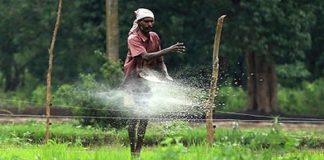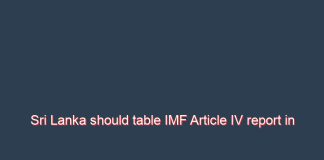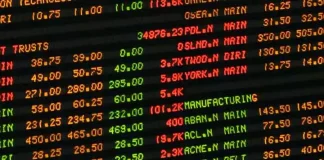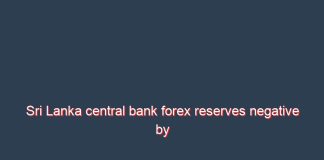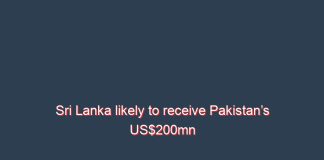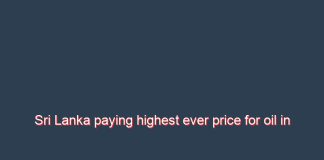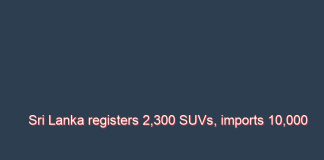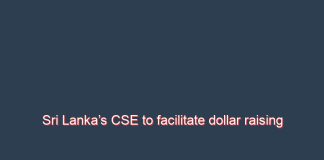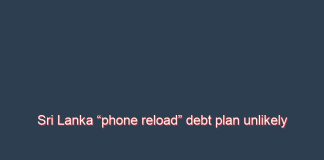Demand spikes for fuel, power generators in Sri Lanka amid power...
ECONOMYNEXT – Sri Lanka is seeing a surge in demand for fuel and power generators since the government announced scheduled power outages from the third week of February as the island nation struggles to ensure an interrupted fuel supply while finding US dollars for imports.
Sri Lanka is facing one of its worst forex and debt cresses in its history as the country’s foreign exchange reserves dwindled to 2.36 billion US dollars in end January, just enough to finance imports for five weeks. The remaining reserves also included swaps from China, India, Bangladesh, and the Asian Clearing Union (ACU).
The state-run utility provider, the Ceylon Electricity Board (CEB), has announceddaily one hour and 45-minute power cuts starting February 18. The power cut duration has now been increased up to three hours in some areas.
Since the announcement, generator suppliers and fuel stations have seen a sudden rise in demand for their products amid rumours that Sri Lanka is running out of US dollars to import fuel.
No dollars, no fuel
Government sources said the Energy Ministry is struggling to find dollars to clear two shipments of diesel which have arrived at the Colombo port.
Energy Minister Udaya Gammapnpila last week said there is an imminent risk of the country facing a fuel shortage before the first week of April.
The state-owned fuel retailer Ceylon Petroleum Corporation (CPC) has been looking for 60 million dollars to clear a petroleum shipment and another diesel shipment on Friday.
A government official said the CPC was able to clear the petrol shipment, but it has yet to clear the diesel consignment. An extra diesel shipment also has arrived at the port, the official said.
As a result, fuel stations in the country have seen a sudden increase in demand for all types of fuel.
“We do not know what the exact reason for the sudden rise in demand. But there are rumours of price increase, smaller fuel stations not having enough fuel, and fuel needed to run generators,” a Colombo based fuel station official told EconomyNext.
Another fuel station manager said: “The lack of fuel in small fuel stations as well as lack of some fuels is the reason for more people to come.”
Many fuel station owners say the stocks of 92 Octane and auto diesel have depleted more than other types of fuel. They say most consumers opt for expensive fuels when 92 Octane or auto diesel, which are among the cheapest, are not available.
Generator demand up
Meanwhile, power generator sellers are unable to meet the sudden rise in demand amid the power cuts.
“We already sold our stocks. There are more enquiries, but we are unable to supply the increasing demand because of the import restrictions that have been imposed by the government,” a spokesman for Circom Power Technologies (PVT) LTD told EconomyNext.
“On the other hand, banks don’t issue Letters of Credit (LCs) due to the forex shortage in the country,” he said.
The Circom spokesman said the company’s maintenance division has seen a corresponding spike in repair and maintenance requests from their clients because people were getting ready to face the worst in the event of a full-blown power crisis.
“We are in a difficult situation because it is restricted to import the spare parts we need,” the official said.
Daya Upasena, the owner of Power Lanka Pvt Ltd, told EconomyNext that their clients are coming in, enquiring about generators and prepared to pay upfront for new machines as soon as they turn up.
“We sold out the stock we had. Now we are getting some dollars from our partners that we plan to invest in about 10 machines,” Upasena said.
“But we have pre orders for about 50 machines at the moment,” he said adding that the firm is looking for new avenues such as renting generators for clients, who are unable to purchase a machine permanently.
The current average price of a three kilovolt-ampere power generators is around 70,000 rupees.
Suppliers have urged the government to relax the ongoing import restrictions so that the industry can survive while being a support service for other industries in addressing the power shortage. However, though the central bank has said there are no such restrictions, suppliers are unable to get dollars from local banks as there is a severe dollar shortage. (Colombo/Feb 22/2022)
Fertilizer compensation decision delayed
Sri Lanka should table IMF Article IV report in parliament: opposition
ECONOMYNEXT – Sri Lanka should table in parliament an International Monetary Fund country economic report which is going to the Washington-based lenders Executive Board on February 25, and come up with a program to save the economy, opposition legislator Harsha de Silva said.
The IMF has a prepared a country report under annual Article IV consultations which also contains a debt sustainability analysis (DSA) which shows whether the debt can be repaid without re-structuring after tightening monetary and fiscal policies.
Debt Unsustainable?
“We are firmly calling on the government to table the Article IV report in parliament,” de Silva told reporters on February 01.
“The report will tell whether the debt is sustainable. From the information available to us it does not look like the debt is sustainable (can be repaid on an on going basis).”
“The debt is most likely unsustainable. The problem cannot be solved simply by going to the IMF. At least now the government should come up with an apolitical economic program to save the country.”
Sri Lanka usually goes to the IMF after the central bank prints money to control interest rates triggering a currency crisis with some forex reserves intact and without a lot of commercial debt.
It can solved by raising rates, floating the currency (to stop sterilized interventions) and narrowing the deficit (to reduce the corrective interest rate). The country however keeps going back the country as activist policy is not curbed through central bank reform.
However from 2014 to 2019, commercial debt racheted up through two currency crises and in 2020 the country lost access to capital markets losing the ability to roll-over debt as credit was downgraded.
The Ceylon Petroleum Corporation was also similarly made to borrow dollars as forex shortages emerged from interest rate manipulations.
The practices have continued for decades with no questions asked from the Mercantilist perpetrators, who blames the general public, who are net savers who do not finances a deficit but has also helped build forex reserves when inflationary policy is not run by the central bank.
Central Bank Discretionary Independence
Sri Lanka’s legislators through a sweeping monetary law has given central bank powers to print money as it wished, depreciate the currency as it wished (parliamentary approval was needed like in the UK in the original central bank law to suspend convertibility or float).
Legislators have also given the central bank draconian power through exchange control laws to cover its policy errors and continue to print money and manipulate interest rates to further depreciate the currency or lose forex reserves or both.
Legislators have also not brought a law to prevent the central bank or Treasury from blocking the publication of IMF reports from the public. The IMF allows countries to block publication of a report in part of in full. Market sensitive data is sometimes redacted.
Related
Sri Lanka govt blocks publication of IMF program report
Sri Lanka disclaims knowledge of IMF economic report, denies suppression
Sri Lanka’s Coomaraswamy brings back transparency to IMF dealings
The central bank during the time de Silva was a minister in the last administration also blocked publication of IMF reports. One report was published more than 18 months after it was considered by the IMFs Executive Board.
Ministers were helpless to stop the activity or even stop the central bank from printing money and busting the rupee.
From 2015 to 2019, the central bank printed money to create two currency crises by manipulating rates through a variety of means as public opposition to outright purchases of Treasury bills through auctions grew.
During the time De Silva was minister in the last government the central bank printed money through term repo auctions, term reverse repo auctions and outright purchases of bonds which have been sold to finance past deficit to target an ‘output gap’ despite taxes being raised to lower the deficit.
Money was also printed in 2018, despite taxes being raised through rupee/dollar swaps using fiscal dollar reserves accumulated from the sale of lease of Hambantota port to target.
Though multiple liquidity injections, by October 2021 when a so-called ‘coup’ happened, the rupee was busted from 153 to 173 to the US dollars. After the ‘coup’ the rupee fell a further 10 rupees as large volumes of reserve sales were sterilized like now.
Legislators however have the lawmaking powers to curb central open market operations, market price interest rates and completely eliminate currency troubles anytime they wish, as other countries without external troubles have done and Sri Lanka did before 1950 keeping the country safe two through World Wars and a Great Depression.
In addition to East Asian nations and the GCC nations, countries like Bhutan and Nepal have maintained fixed exchange rates for more than half a century, through with a bad anchor currency (Indian rupee).
Analysts have called for strict laws to prevent activist policy by the Monetary Board to stop inflation, currency depreciation, economic volatility (stop-go policies), output gap targeting, REER targeting social unrest and otherwise curb the agency’s ability to impoverish the general public through monetary expropriation.
Debt Re-structuring
If debt is unsustainable, Sri Lanka will have to re-structure debt, de Silva said.
In that case ‘senior creditors’ like the World Bank, Asian Development Bank and IMF will have to be repaid (the loans are instalments and not bullet repayments.
If the DSA shows the problem is small, a light restructuring of some debt could be done, he said.
However if the problem is acute a bigger restructuring would be needed, he said.
“Bi-lateral lenders of the Paris Club would have to be also brought in,” de Silva said. “However without IMF involvement they will also not participate.”
Analysts have warned that with or without re-structuring the practice of giving reserves for imports will have to be halted through a rate hike and a float.
If not, the re-structured debt will default. IMF programs however involve a monetary program, as well as a fiscal program. There will also be structural reforms to boost growth after the currency is stabilized.
IMF programs usually fail however and countries go back to the agency due to lack of central bank reform, which is what triggers, trade and other controls. (Colombo/Feb22/2022)
Sri Lanka stocks suffer worst loss since October 2020 as margin...
ECONOMYNEXT – Sri Lanka’s stock index plunged 4.47 percent on Monday (21) to its lowest since October 2020 as margin calls on declining shares and economic woes visibly kicked in the form of power cuts and fuel shortage weighed on investor sentiment, brokers said.
The main All Share Price Index (ASPI), closed 542 points lower at 11,591.37 points, its lowest since October 05, 2021.
The index has lost 5.9 percent so far this year and 10.2 percent so far for the month despite listed companies posting better than expected earnings in the December quarter.
“We usually see sales at month ends, but it has worsened with the reports of power cuts and fuel shortages as the people feel the brunt of the economic crisis in the country,” a top analyst said.
“I expect the trend to continue till the month-end. I don’t think there will be a recovery any time soon and if the power cuts aggravate definitely it will worsen.”
Another analyst said the margin calls have forced investors to sell their shares to recover credit for stock purchase.
Sri Lanka announced a maximum three hour power cut as the country’s forex shortage has led to fuel scarcity due to lack of dollars to import fuel.
SL20 of the more liquid index closed 5.02 percent or 207.88 points weaker at 3,932.78. The fall of this index prompted the market to temporarily halt trading as the plunge was over 5 percent.
Analysts had predicted a downtrend in the market due to the uncertainties in the market and the economy. The market lost 2.6 percent last week.
The day’s turnover was 4.2 billion rupees, lower than this year’s average turnover of 6.8 billion rupees.
The market has been in a declining trend due to the ongoing forex crisis most companies are going through, despite many companies posting better-than-expected earnings in the December quarter.
The rupee exchange rate is fixed at around 200 rupees by the central bank, but it is now above 250 rupees per dollar in the grey market.
Foreign investors, who are highly worried about possible sharp depreciation or devaluation in the currency, bucked the trend and bought a net of 79.9 million rupees worth shares on Monday.
The foreign sales of shares so far this year have been 3.3 billion rupees. In 2021, the Sri Lanka stock market suffered a net foreign outflow of 50 billion rupees.
Analysts had predicted that the economic concerns would drag the market from time to time until the government finds a sustainable solution for the country’s looming debt crisis.
LOLC Holdings, Expolanka and Royal Ceramic dragged the market down on Monday.
LOLC Holdings fell 9.41 percent to close at 1,025.00 rupees a share, while Expolanka, the market heavyweight that has export and freight businesses plunged 8.49 percent to 288.00 rupees a share.
Royal Ceramic lost 7.96 percent to 61.30 rupees a share. (Colombo/Feb21/2022)
Sri Lanka central bank forex reserves negative by US$1.9bn by Dec
ECONOMYNEXT – Foreign exchange liabilities of Sri Lanka’s central banks has further exceeded its reserve assets to reach 386 billion rupees (1.9 billion US dollars) in December 2021 compared to its gross reserves of 3.1 billion US dollars in the month.
The central bank’s foreign exchange liabilities or almost reached its gross assets in July 2021, after a billion US dollars bond payments as money printing created forex shortages making it impossible to collect forex reserves.
The central bank’s net foreign assets were positive by about 2.1 billion US dollars at the beginning of 2021, which fell to around 50 million US dollars by July.
In August foreign assets turned negative (reserve liabilities exceeded assets) by around 400 million US dollars.
Since then the central bank’s gross and net liabilities have been climbing as foreign exchange was borrowed from swap contracts.
The central bank also got a special drawing rights allocation from the International Monetary Fund, which also becomes a net liability as soon as soon its underlying holding was used.
The central bank’s liabilities also include borrowings of a little under 1.3 billion US dollars from the IMF on given during a money printing bout from 2015 to 2018.
Central Bank has increasingly become indebted as central government debt was paid off with reserves. From around October reserves are also being used to pay for imports, further indebting the central bank.
Sri Lanka last used foreign reserves for imports during the money printing crisis of 2018. Before commercial debt became a big factor, all of Sri Lanka’s past currency crises have been caused by ‘reserves for imports’ and keeping a fixed policy rate.
To keep the policy rate a (soft-pegged) central banks prints money after giving reserves for imports (sterilizes the reserve sale), triggering more credit and imports.
A central bank with net foreign liabilities can default on its debt and also lose control of reserve money, which has led to dollarization in some countries.
Sri Lanka’s has a Latin America style central bank promoted by Argentina central bank founder Raul Prebisch and US Fed official Robert Triffin. Many of Prebish-Triffin central banks have gone bankrupt amid galloping inflation, severe depreciation amid sovereign default and dollarized.
Some were re-capitalized. Analysts and economists have called for changes to its governing law to prevent the monetary board from controlling interest rates by printing money, which creates forex shortages, inflation and social unrest. (Colombo/Jan21/2022)
Sri Lanka likely to receive Pakistan’s US$200mn credit line after top...
ECONOMYNEXT – Sri Lanka is likely to receive a 200 million US dollar credit line from Pakistan for essential food, rice, and cement, sources who are aware of the deal said as the island nation is grappling with a severe foreign exchange crisis.
“It is likely to be signed when a Sri Lankan leader visits Pakistan possibly before the end of this year,” a source who is aware of the progress of the deal told EconomyNext.
Sri Lanka has already borrowed 1.5 billion US dollars from People’s Bank of China, 400 million US dollars from Reserve Bank of India (RBI), and 250 million US dollars from Bangladesh Central Bank via swap arrangements to boost its reserves and avoid a possible sovereign debt default.
Pakistan’s credit line talks come as Sri Lanka’s rice crop may fall 30 percent or more after an overnight ban on fertilizer to save foreign exchange and stop agro-chemical use.
A source from Pakistan who is aware of the ongoing discussion over the credit line said the original request, which came in September last year, was only focusing on a credit line for rice and cement.
However, when Sri Lanka’s Trade Minister Bandula Gunawardena visited Islamabad in January, Pakistan was asked to extend the deal also for essential commodities as well.
“In principle, the Pakistan Prime Minister has approved this and it is in process,” he said.
“The deal will be signed when a Sri Lankan leader visits Pakistan.”
Sri Lanka is trying to finance imports of essential commodities including food and medicines through credit lines for this year amid forex shortages as it is facing risk of sovereign debt default.
Sri Lanka has a habit of going for credit lines every time money printing trigger forex shortages. Credit lines allows imports and consumption to take place on credit or a financial account inflow. Central bankers and other policy makers then complain that the external current account has widened.
The island nation has already signed a 500 million credit line with India to buy fuel from India and Sri Lanka expects to start using this credit line from the first week of April.
India also has agreed for a 1 billion US dollar credit line for Sri Lanka to buy foods and medicines.
Sri Lanka also has been in discussion with Australia for another 200 million credit line to buy lentils and essential foods, local media has reported. (Colombo/Feb21/2022)
Sri Lanka paying highest ever price for oil in rupees depreciated...
ECONOMYNEXT – Sri Lanka is currently facing its highest ever crude oil price in the local currency because of a steep depreciation in the rupee, Energy Minister Udaya Gammanpila said, though global prices are below the level when the Fed’s housing bubble collapsed in 2008.
The global crude oil price was at 95 US dollars per barrel as of February 16 in the current bubble fired by Fed Chief Jerome Powell, much lower than the record price of 147 US dollars fetched in May 2008 amid the Bernanke-Greenspan bubble which collapsed shortly after.
However, Minister Gammanpila said Sri Lanka is already facing its historically highest price.
“When the global crude price was at 147 US dollar per barrel in 2008, our rupee was 108 per dollar. So we paid only 15,876 rupees per barrel of crude at that time,” he told a media briefing on Friday (18).”
“However, now the rupee is 203 rupees and the crude price is 95 US dollar per barrel. As a result, now we have to pay 19,285 rupees. This is the highest ever price.”
Sri Lanka rupee has collapsed in a series of currency crises in 2012 (to 131), 2015/2016 (to 151), 2018 (182) as the central bank printed money to control short term interest rates and ‘stimulate’ the economy.
The rupee is facing downward pressure in the latest currency crisis, which is still ongoing. The rupee has is now around 202 to the US dollar and parallel exchange rates are around 248 rupees.
Countries with untamed central banks like Pakistan and Sri Lanka face ever depreciating currencies, ever rising fuel and electricity prices, as well as ever rising debt, when the ruling class tries to deceive the public by not market pricing energy to reflect global prices and central bank depreciation.
So-called ‘circular debt also expands between the petroleum utility and the power utility and between the power utility and independent power producers (IPPs) as the currency is depreciated from money printing and prices are controlled.
Sri Lanka and Pakistan central banks have also among the highest reported inflation in Asia.
In sharp contrast Singapore has now started to appreciate its currency to ward off inflation generated by the Federal Reserve and European Central Bank which was misled by modern monetary theory and Keynesian ‘stimulus’ dogma.
In 2008 June, when Brent crude hit 138 US dollars a barrel, it was worth 181 Singapore dollars and 14,261 Sri Lanka central bank rupees.
By January 2022, when a Brent crude barrel hit 83 dollars, it is measured in 135 Monetary Authority of Singapore dollars.
In Central Bank of Sri Lanka rupees the same Brent barrel has to be bought at 17,000.
Singapore resisted setting up a money printing central bank based on Anglo-US stimulus dogma.
Sri Lanka is now in serious economic trouble with looming sovereign default after printing money (expanding central bank credit) to create a ‘production economy’.
“The way to a better life was through hard work, first in schools, then in universities or polytechnics and then on the job in the work place,” Singapore’s first Finance Minister Goh Keng Swee has said.
“Diligence, education and skills will create wealth, not Central Bank credit.
“There was no effective way of exchange control in an open trading economy like ours to deal with the inevitable balance of payments troubles.
“Hence, we were not impressed by claims — excessive as they turned out to be — that government could bring about prosperity through spending. It did not surprise us that the Anglo-Saxon countries which adopted such policies got into trouble.
“We also noted that the Germans and Japanese did not believe they could “spend their way to prosperity”, as the phrase went. Like Singaporeans, they set store on diligence, education and skills.”
Keynesian dogma became fashionable especially after the Federal Reserve printed money and created the Great Depression.
Such teachings, a regurgitation of Mercantilist teachings of John Law among others, became the standard dogma is many UK and US universities going against 200 years of classical economic theory.
“When nearly two-thirds of our citizens’ expenditure is spent on imported goods, a strong Singapore Dollar helps to keep consumer prices down,” Goh said.
“…[W]e wanted to indicated to academics, both local and foreign; that what is fashionable in the West is not necessarily good for Singapore. A perceptive mind is needed to distinguish the peripheral form the fundamental, transient fads from permanent values.”
”…[I]n poor countries, punishment comes quickly in a cruel way — high rates of inflation, economic decline and political instability. These three factors reinforce each other in a way which makes escape from misery difficult. (Colombo/Feb20/2022)
Sri Lanka registers 2,300 SUVs, imports 10,000 tractors in 2021
ECONOMYNEXT – Sri Lanka has registered 2,300 SUVs and imported 10,000 tractors in 2021, data show as import controls prevented highly taxed imports like cars and three wheelers from coming into the country.
Sri Lanka banned imports of most automobiles including three wheelers and motorcycles which give large revenues to the state, as money printing ratcheted up from February 2021 (monetary stimulus) creating forex shortages.
Meanwhile imports of low taxed items, such machinery and construction material, was encouraged including through artificially low interest rates, creating vicious cycled of revenue losses and more money printing, which in turn creates more forex shortages.
Sri Lanka had registered 2,384 SUVs in 2021 and 176 in January 2022, Sri Lanka’s vehicle registry data analyzed by JB Securities, a Colombo-based equities brokerage show.
In January 176 SUVs were registered.
“SUVcrossovers recorded 176 units in Jan up from 100 units the previous month but down from 199 units 12 months ago,” the research house said in a note to clients.
“Mahindra accounted for 118 units through its KUV 100 model – a small cross over vehicle assembled locally by Ideal Motors. The records also show registration of 28 Toyota Land Cruiser jeeps – they were a gift from the government of Japan to the Sri Lanka Police.”
Knocked down vehicles components pay sharply lower rates of tax, reducing tax revenues to the state.
Sri Lanka had also registered 8,067 large tractors and 2,116 small tractors in 2021.
Regardless of the administration in power Sri Lanka’s policy makers and economists, steeped in Mercantilist ideology control trade after printing money to create forex shortages.
Then a series of cascading policy errors – also based on Mercantilist dogma – including banning highly taxed items worsen the economic crisis, drives the country into currency collapses and the International Monetary Fund.
Meanwhile Sri Lanka’s central bank Governor Nivard Cabraal has suggested that people who earn foreign exchange overseas be allowed to import cars and also pay taxes in US dollars to the state.
As part of legal tender laws to encourage domestic money, countries usually make citizens pay taxes in domestic money. However when money is printed making outflows exceed inflows, governments find it difficult to convert the rupees into dollars to pay overseas obligations.
Taking taxes directly into the state coffers in US dollars drops the intermediate stage.
In 2021, Sri Lanka imported 1.66 billion US dollars of food and beverages, another 418 million US dollars of wheat and maize.
In 2021 machinery and equipment imports topped 2.8 billion US dollars and building materials 1.2 billion US dollars. (Colombo/Feb19/2022)
Sri Lanka’s CSE to facilitate dollar raising amid forex crisis
ECONOMYNEXT – Sri Lanka’s Colombo Stock Exchange (CSE) will introduce a measure to facilitate local companies to raise funds in foreign currencies, a CSE official said, as the island nation is facing a forex crisis after the central bank’s excess money printing.
Sri Lankan importers are struggling to get adequate US dollars as they cannot open letter of credit with local banks due to forex shortage as the country’s foreign currency reserves plummeted over 50 percent last year alone.
The CSE’s new move, which was approved last week by the regulator Securities and Exchange Commission (SEC) will allow Sri Lankan companies seeking to fund foreign currency projects to raise capital in offshore currencies by listing at the Exchange, a CSE official said.
“Companies which have earned over 50 percent of their revenue in foreign currencies in the last three years with a minimum revenue of 5 million US dollars are eligible to use this option,” the source told EconomyNext.
Though the central bank banned many imports last year, the 2021 import bill hit a three-year high as lower interest rates amid excess money printing made imports cheaper.
The move comes at a time the central bank has been struggling to raise dollar loans to boost its reserves, which fell by more than a quarter in January.
Analysts blame the central bank’s parallel currency exchange for the lack of dollar inflows from remittances and exports.
Though the central bank has fixed the exchange rate at around 200 rupees per dollar, the US currency is sold at around 250 rupees in the grey market.
Sri Lanka is unable to tap international capital market for foreign currency loans as global rating agencies have downgraded its credit rating to its worst in the history due to risks faced in foreign debt repayment.
The central bank, however, has repeatedly said it can manage foreign loans and will not default any.
Sri Lanka “phone reload” debt plan unlikely to save economy: legislator
ECONOMYNEXT – Sri Lanka’s current debt repayment strategy which is similar to reloading a pre-paid mobile phone is unlikely to get the country out of a looming economic crisis as money printing and dollar shortages take a toll on the island nation, opposition legislator Patali Champika Ranawaka said.
Sri Lanka has been downgraded to ‘CC’ by Fitch indicating heightened risk of sovereign default while foreign reserves have been depleted while being exchanged for newly minted money which is turning up as imports.
Sri Lanka has been borrowing from foreign governments and central banks has also borrowed through swaps to repay part of the maturing debt, as money printing created forex shortages, instead of running deflationary policy to turn current account inflows to financial account outflows.
Reload
“The government is insensitive to the financial crisis. It is managing debts as like reloading prepaid mobile phones,” Ranawaka told a meeting with Foreign Correspondents’ Association (FCA) in Colombo.
The last administration also printed money, created forex shortages and borrowed under a so-called Actively Liability Management Law, ratcheting up foreign debt, instead of running deflationary policy, analysts have shown.
In January 2021, India came up with a 400 million US dollar swap, a deferment of cross border payments due under regional clearing arrangement, a 500 million dollar petroleum credit line and another billion US dollar food and medicine credit is planned.
“Hadn’t India bailed out Sri Lanka in January, we would have faced bankruptcy by now,” said Ranawaka, one of the key ministers in the last government who oversaw the completion of Chinese Port City under his ministry purview.
Inflationary Policy
Sri Lanka has been printing money to boost growth for several years instead of doing serious reforms to allow private sector activity to take off, engaging output gap targeting until 2019, and full blown fiscal stimulus backed up by money printing from February 2021.
By January 2021 12-month inflation had hit a 14.2 percent.
The new money trying to rush out of the country, has pushed up premium in the kern market and Undiyal/Hawala settlement system, diverting money away from the formal banking system.
Relatives of those who receive remittances via informal methods claim they get 250 rupees for each US dollar, nearly 20 percent higher than the central bank’s rate of 210 rupees, which also includes a 10-rupee incentive of which at least 8 rupees are printed money.
Delays in getting dollars to match the excess rupees being produced had led to shortages of cooking gas, milk powder, sugar, car spare parts as well as inputs for industries.
The central bank has already banned imports to preserve dollars which has led to shortage of imported milk powder, wheat flour, and many other food items.
“The government is repaying the loans at the expense of the people’s needs. It has deprived the people of having milk powder and fuel,” Ranawaka claimed.
However the central bank has given 967 million US dollars for imports since October 2021 when a 200 to the US dollar peg was strict was strictly implemented, data show.
Unless money is printed, the central bank does not give any reserves for imports, but instead collects reserves. Large volumes of reserves were given last in 2018, when money was printed to target an output gap.
Money Printing Tax
Ranawaka questioned the current administration’s spending priorities, when revenues were down after tax cuts.
“They are expanding the express highway network,” Ranawaka said. “But they are doing that when there is a financial crisis. This is not a time to spend money on infrastructure. This is a time to look into the people’s essential needs.”
Despite the country’s looming financial crisis, Finance Minister Basil Rajapaksa announced a relief package for an already bloated public sector employees as well as pensioners and paddy farmers who were hit by a fertilizer ban.
“When the finance minister is increasing expenditure without raising revenue, he is not only digging his own grave, but the graves for all of us,” Ranawaka said.
“We need to increase revenue, but not by taxing the people more. People are already taxed by both commodity scarcity and by the way of money printing.”
“The money printing is also a way of imposing more tax on the public. High expenditures should be curtained. You can’t expand the highways at this juncture. First of all, there should be food for people’s survival.” (Colombo/Feb19/2022)

